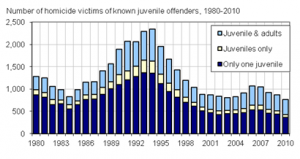Youths are involved in murders, either as victims or perpetrators, at about the same rate as they have been for the last few years, according to newly gathered statistics. Both figures are far down from an early 1990s peak.
 In 1994, juveniles were involved in committing more than 2,300 murders. The year before that, nearly 3,000 minors were murder victims.
In 1994, juveniles were involved in committing more than 2,300 murders. The year before that, nearly 3,000 minors were murder victims.
In 2010, the statistics had fallen to 788 and 948 respectively, according to data recently published by the federal Office of Juvenile Justice and Delinquency Prevention, which complies figures voluntarily reported by many jurisdictions nationwide, including the largest urban areas in the country. For the past decade, neither number has gone above 1,100.
Some people will say “the question isn’t so much why did they come down but why did they go up,” in the early 1990s, said Melissa Sickmund, interim director of the National Center for Juvenile Justice, the nonprofit that developed the OJJDP’s Briefing Book.
“I don’t think that anyone has definitively said ‘this is it, this is the reason,’” for the change in the statistics over the decades, she said. It’s most certainly several things at work.
She says studies show the 1990s numbers may have come from “volatility in the drug market when crack hit the streets.” As dealers and drug lords battled to stake out territory in a new market, they recruited the young and put guns in their hands.
Programs like Boston’s Gun Project also play a part, she said. When that program was in place, police cracked down on gun traffickers and gangs in certain key areas. The juvenile murder victim rate fell by half. Even better emergency room care drives down the murder rate by saving more lives.
police cracked down on gun traffickers and gangs in certain key areas. The juvenile murder victim rate fell by half. Even better emergency room care drives down the murder rate by saving more lives.
Buddy Howell agrees that there’s no one proven factor behind juvenile-involved murder. He’s written about and studied the problem for more than two decades and is now senior research associate at the National Gang Center, a federally funded research body. He said gang-related murder rates are stubbornly steady.
“Gangs don’t seem to be affected by so-called national trends,” said Howell. “The gang problem really varies from one city to another.”
There were about 2,000 gang-related murders annually from 2006 through 2010, according to the National Youth Gang Survey. Howell cautioned, however, that the data also includes gang members over the age of 18 and only counts mostly the few hundred most populated counties.
Yet that probably catches the vast majority of murders, which are overwhelmingly concentrated in a handful of urban counties. Los Angeles and Chicago alone account for about half the murders. Conditions that make neighborhood kids more at risk for joining gangs, like unemployment and poverty, don’t change in big cities, Howell said.
